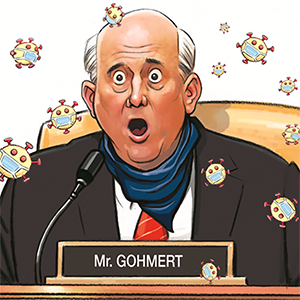Penn and CHOP will test gene therapy for rare diseases with a new FDA trial protocol
Published in News & Features
Earlier this year, researchers at Children's Hospital of Philadelphia and Penn created a first-of-its-kind drug customized to a unique genetic mutation to save an infant named Baby KJ from dying of a rare liver disorder.
KJ Muldoon’s doctors used CRISPR, the buzzy shorthand for a scientific tool that works like a find-and-replace command, to locate the genetic misspelling that prevented his body from producing a key enzyme that breaks down protein. They then infused a medication laced with bits of genetic code to fix the misspelling, dramatically improving his chances of survival.
The drug will never be given to another patient, but researchers believe the approach could be replicated to help other patients with rare diseases, customizing bespoke drugs to target different genetic misspellings.
They now have a way to put their theory to the test. The U.S. Food and Drug Administration on Wednesday announced a new approach to clinical trials to test one-of-a-kind drugs like the one CHOP and Penn doctors created for KJ.
The approach creates a pathway toward regulatory approval — and insurance coverage — for rare-disease treatments that, in the past, would have had little chance of reaching the market because they benefit so few people.
The FDA’s protocol addresses a longtime challenge in developing treatments for rare diseases: Scientists struggle to identify enough patients to create a critical mass in trials, and pharmaceutical companies are reluctant to sink millions of dollars and years of time into developing a drug that, ultimately, will benefit very few people.
Now the FDA’s new “plausible mechanism” protocol will create a way for Philadelphia researchers to test the CRISPR framework for treating customized gene therapies for urea cycle disorders related to any one of seven genes. The mechanism will remain the same, but the injection each patient receives will be customized to target their unique genetic mutation.
The Philadelphia team — led by Kiran Musunuru, a cardiologist and leading gene-editing expert at the University of Pennsylvania, and Rebecca Ahrens-Nicklas, a metabolic disease specialist at Children’s Hospital of Philadelphia — hope their work will be a model for rare-disease drug development.
“As academics, we think of ourselves as the top of the spear, going where the companies are reluctant to go,” Musunuru said.
Their goal, he said, is to show pharmaceutical companies that rare-disease drug development is feasible on a larger scale. They published details about their interactions with the FDA in the American Journal of Human Genetics in October.
Though each rare disease is uncommon, millions of people have a rare disease. Many have shared characteristics that could potentially be addressed through a customizable drug.
Using CRISPR to treat rare diseases
KJ’s treatment was a new application for CRISPR, a gene-editing tool with an unlikely origin story involving quality-control tests on bacteria used in making yogurt.
Scientists discovered that bacteria keep records of the DNA of viruses that attack them. These microbial “mug shots” can be utilized to pinpoint a genetic misspelling in a patient’s DNA.
A type of enzyme is then used to “cut” the misspelling and either correct it or eliminate it.
Earlier this year, KJ’s doctors announced they had used the technology to develop a custom drug using information about his specific gene mutation.
They worked with outside research and manufacturing partners to quickly produce the drug and test it for safety. They were granted expedited authorization by the FDA under rules designed to fast-track treatments for rare diseases.
The approach was life-saving for KJ, who returned home in June after 307 days in the hospital and will need ongoing treatment.
An identical drug can never be used for another patient. And handcrafting drugs for rare-disease patients one by one isn’t feasible.
Building on KJ’s treatment
To reach more patients with their gene-editing therapy, Musunuru and Ahrens-Nicklas needed to find a way to create a drug that could be produced on a larger scale.
What’s more, they needed to be able to apply for FDA approval, the gold standard for drug safety in the United States, without which most insurance companies won’t cover drugs.
Typically, drug developers focus on a specific treatment for a specific disease, investing millions of dollars for up to a decade to bring the drug to market.
Instead, Musunuru and Ahrens-Nicklas worked with the FDA to create a trial protocol that would allow them to test a drug platform that could be customized for individual patients.
“Power in numbers is a real thing, to be able to tell if a drug is effective,” Musunuru said. “If you were to try to stand up a trial for each of these seven, it would be cost prohibitive.”
They plan to keep key elements of the treatment the same: CRISPR will identify the genetic misspelling, and patients will receive a drug laced with bits of DNA to correct it. The exact gene that’s targeted will depend on each patient’s specific disorder.
They plan to test the drug on patients with urea disorders, which affect the body’s ability to break down protein and excrete ammonia, because these conditions have more visible “biomarkers,” or indicators that show what the problem is and whether the gene-editing therapy has helped.
“We measure what builds up, and what we’re missing,” Ahrens-Nicklas said.
For example, KJ had a genetic mutation that prevented his body from creating an enzyme that processed protein. Doctors could readily test that his body lacked the needed enzyme and that his organs weren’t getting protein.
After giving him the custom-made treatment, they could see that the enzyme count had increased, and that more protein was being processed.
A new FDA pathway for rare disease treatment
In a New England Journal of Medicine article outlining their plan, FDA Commissioner Marty Makary and Vinay Prasad, the agency’s chief medical and scientific officer, pointed to KJ’s single-patient gene therapy as an example of how they hope the new protocol will help scale up to reach more patients.
KJ’s therapy was initially approved by the FDA in an expedited, one-week review process that is designed for use for a single patient, typically one who is severely ill with an ultrarare disease.
Prasad and Makary wrote that “current regulations are onerous and unnecessarily demanding, provide unclear patient protection, and stifle innovation.”
KJ’s case “highlights the potential” for single-patient therapies to be developed into a drug that could be modified to address other, similar rare diseases, they wrote.
“Nearly 30 years after the sequencing of the human genome, bespoke therapies are close to reality,” they wrote.
©2025 The Philadelphia Inquirer, LLC. Visit at inquirer.com. Distributed by Tribune Content Agency, LLC.






Comments